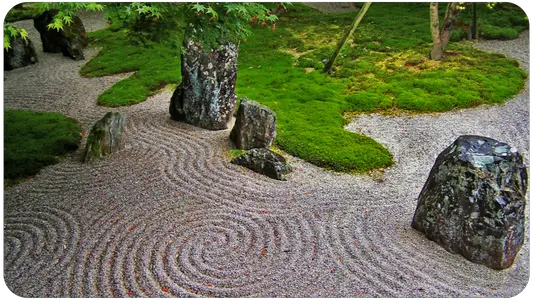The term zazen (坐禅) refers to a broad set of meanings, roughly translatable into Italian as "seated meditation," currently referring to practices, mostly, from the sphere of Japanese Zen schools developed from the Buddhist current that arose in China between the fifth and sixth centuries and was known from the ninth century onward under the generic name Chanjia (禅家), "schools/families/houses of the Chan," a name first adopted-it seems-by the famous and eclectic Chinese monk and scholar Zongmi (宗密) (780-841).
Origins of the term
In all likelihood, the Chinese ideograms 坐禅 read "zazen" in Japanese and transliterated "zuochan" in Chinese, were first used side by side by the Buddhist monk Kang Senghui, a native of Sogdiana, when he translated the Sūtra of sitting in dhyāna into Chinese between the 2nd and 3rd centuries under the title Zuochan jing, 坐禅 經.
However, the term zuochan/zazen/坐 禅 was certainly also used by Kumārajīva, around 402, when he inaugurated the Chang'an (now Xi'an) school of text translations by translating the Sūtra of the samādhi of sitting in the dhyāna with the Chinese title Zuòchán sānmèi jīng, 坐禅 三昧 經 (T.D. 614).
The logical origin of this pairing of ideograms is to be found in a symbolic and practical intent together: it is well known that Chinese Buddhism is a new form of Buddhism that arose from the encounter-which occurred all within Chinese culture, that is: among Chinese-of Indian Buddhism with the body of culture that developed in China between the sixth century B.C. and the beginning of the Vulgar Era.
In particular, from the intimate relationship between the study and practice of the Mādhyamika and Yogacārā/Vijñānavāda or Cittamātra (literally: matrix mind) schools consummated in the Daoist milieu, there arose what was later called the "Chan school."
In Daoism, and particularly we find it in Zhuangzi VI, there was 坐忘, zuowang, "to sit in forgetfulness" or: "to sit in forgetting" and also: "to sit (and) forget," an expression whose first character is 坐, zuo, (za in Japanese).
At the same time, it was clear that the princely practice that came from India with Buddhism was that called dhyāna in Sanskrit (jhāna in Pāli), a term that in Chinese was transliterated as 禅, read chan'na, later shortened to "chan," in Japanese read "zen."
The two ideograms 坐 and 禅 thus represented the meaning and symbol of the two "parents" of what would later be the chan/zen school. Bringing them together simultaneously represented the sign of the new and the link with the ancestors.
Zazen in Buddhism
Within the Buddhist religion, zazen occupies a special place. The texts that have been written about it emphasize its long tradition, while at the same time questioning the very definition of the practice.
If it is true that the pinnacles of the Indian mystical tradition and the elusive wisdom of the Dao had been able to "look each other in the eye" it meant that neither could claim, exclusively, a certificate of membership of the new school, which would be, then, "neither this nor that," outside of any verbal and therefore doctrinal transmission.
Eihei Dōgen very lucidly expresses this conception on a couple of occasions, in Shōbōgenzō Bendōwa, 正法限蔵 辨道話, and in Shōbōgenzō Butsudō 正法限蔵 仏道 where, among other things, he says: "The virtue and essence of the Way of the Buddhas has been transmitted without a single bit of it being lost.
It has been transmitted from the Western Paradise [India] to the Eastern Paradise [China] crossing thousands of miles and for nearly two thousand years from the time of the Buddha to the present day.
Those who are unaware of this call "Zen school" the shōbōgenzō nehanmyōshin, ["custody of the heart's vision of authentic reality in limitless freedom"], which was correctly transmitted by the Buddhas and patriarchs. They call 'Zen patriarchs' the patriarchs.
They call 'Zen monks' or 'Zen students' the practitioners. They call themselves 'Zen followers'. They are leaves and branches born from the root of a stereotypical view. In India and China, since ancient times, it has never been called 'zen'."
We speak of the "nameless" so even the use of the appellation "zen" is totally inappropriate.
The inner how
The earliest descriptions of zazen/zuochan, or at least of the inner experience related to simply being seated, are iconic phrases, sort of slogans that characterize strands of teaching.
Thus we pass through the "there is neither spirit (mind) nor Buddha" of Niutou ("Oxhead") Fǎróng to arrive at its opposite, the exhortation "to be spirit, to be Buddha" that belongs to the great Mazu Daoyi.
Transiting through Shitou ("Stone Head") Xiqian who about his own inner experience said, "The vast sky does not hinder the white floating clouds." Recall, then, the "shining in silence" advocated by Hongzhi Zhengjue.
To arrive, in the 13th century at the "freeing of body and mind: body and mind liberated" of Tiantong Rujing and Dōgen. In more recent times we had "opening the hands of thought," by Uchiyama Kōshō and "doing zazen is the end of everything," the well-known "motto" of his predecessor Sawaki Kōdō.
From the end of the ninth century, manuals were being compiled in China concerning how it is possible to concretely implement in our lives what in the Dasheng Qixinlun, or Treatise on the Awakening of Faith in Mahāyāna, the most important composition in Chinese Buddhism, is called the "process of dissolving identity in the absolute."
In 1103 Changlu Zongze compiled a monastic codex called Chanyuan Qinggui 禪苑清規, The Pure Rules for the Chan Garden/Monastery, in which there is a section called Zuochanyi, 坐禪儀, The Rite/Form of Zazen, where it is explained how to practice zazen: a short, effective, clear text.
Dōgen comes into possession of it during his stay in China; back in Japan he composes the Fukanzazengi 普勧坐禅儀, The Form of Zazen that is Universal Invitation, which in the first draft is virtually identical to the Zuochanyi, except for a few phrases of minor interest that Dōgen omits.
In the second draft, the most important part, which is about the inner experience of those who sit in zazen, is replaced by Dōgen with a famous sentence, which also appears in Jingde chuandeng lu, The Collection of the Transmission of the Lamp of the Age of Luminescent Virtue.
The sentence in the first draft, taken from the Zuochanyi, was, "When a thought appears be immediately aware of it; as soon as you are aware of it it will disappear. If you remain oblivious to objects for a long time, you will naturally be unified.
This is the art of zazen." In the second version, the phrase-known in the literature as The Nonthinking of Yueshan-that replaced the one above is, "Sit solidly still, think the non-thinking. How to think the non-thinking? By not thinking.
This is the art of zazen." This last version, which is definitive for the Fukanzazengi, appears virtually unchanged in the Shōbōgenzō Zazengi, 正法限蔵 坐禅儀 and in the Shōbōgenzō Zazenshin, 正法限蔵 坐禪箴, the other two zazen manuals that Dōgen left us.
We can therefore say that in these two sentences (the one about Changlu Zongze and the one about "Yueshan's non-thinking") is contained the synthesis of the description of the inner process called zazen, a synthesis that ties together the history of Chan and that of Zen.
Another depiction of zazen, which is very interesting because while saying the same thing it reverses the perspective, is found in Shōbōgenzō Busshō, 正法限蔵 仏性, where Dōgen, in relation to Nāgārjuna, describes its zazen with the words "being body." The words "being body.
It is very important, however, to understand that zazen is not a technique for fulfilling a wish, a tool like others that can make us achieve or attain something: a state of mind, a result. If that were the case, we would be far from the spiritual conception of gratuitousness.
Zazen is spiritual realization itself, the end or, more dynamically, the enactment of the end. This is why Dōgen, in the fourth section of Eihei Kōroku, says, "zazen itself is the form of awakening." Finally, and here the optimistic face of Zen appears, in the Shōbōgenzō Zazengi Dōgen calls it "the dharma gateway to joy and serenity."
This expression has accompanied zazen since time immemorial, appearing as early as the chapter entitled Sukhavihāra of the Lotus Sutra, then in Changlu Zongze's Zuochanyi cited above and finally in Dōgen. It is given to each person to verify it with his or her own experience.
The how of the body
Although zazen is not learned through words but by living it day by day possibly in contact with those who are already experts in that art, there has been, for centuries, a meticulous description of how the body must pose in order for zazen to be such:
"One sits on the round cushion and crosses the legs. The right foot on the left thigh, the left foot on the right. This is the position called the lotus position. Keep the neck erect and tuck the chin in slightly. The lips and teeth are closed without being contracted; the tongue rests against the palate so that there is no air or saliva in the mouth. Straighten your head as if you are trying to pierce the ceiling. Instead, the shoulders are relaxed, loose from all tension."
(Uchiyama Kōshō, Seimei no jitsu butsu)
"The posture is with the legs crossed either fully [kekkafuza], or incompletely [hankafuza]. Sit upright, without tilting either to the right or left, forward or backward. The ears should be in line with the shoulders; the nose should be in line with the navel. The tongue rests against the palate. The jaws and lips are closed effortlessly. Keep the eyes open at all times. Breathe quietly through the nose."
(Eihei Dōgen, Fukanzazengi)
The difficulties of posture
Of current concern to the Western reader is the issue related to the difficulties of maintaining, or achieving, a correct posture by crossing the legs even for limited periods of time.
In its passage through centuries and cultures, this is the first time that zazen has been established in a culture in which the habit of sitting at floor level has been lost for many generations, a culture where the generalized use of chairs has caused (almost) all its adult members to lose the natural elasticity of the legs, that elasticity necessary to sit in the lotus or half-lotus position.
It is evident then that, especially since this is a general problem, this difficulty must be approached with the utmost care by anyone who places himself in the position of "offering" zazen: depending on how this problem is approached and set up, by far different will be the outcomes of the relationship with the practice of all who approach it.
It is not possible to give all-encompassing directions on how to overcome the difficulties arising from bodies that have lost the elasticity necessary to spend long periods of time cross-legged.
Each person's starting conditions, needs, and determination are different on a case-by-case basis, plus there are a number of people who, due to disease or trauma, will never be able to sit cross-legged.
Also because of the relative novelty of the problem- zazen has been practiced in the West for about a hundred years, less than 50 at a widespread level-there are no specialized publications on the subject in Italy, apart from a booklet.
However, it is important to note that the zazen posture consists of a certain form, and that form involves the legs being in the position known as the lotus or the half-lotus position.
It is equally important to consider that once we enter the great river of practice we are all sailing together in the same direction even though there is no doubt that the deep, fast and steady middle current is different from the current near the banks, where stops and hesitations are frequent. Thus each person, in tending to the best, is in his or her place without missing anything.
A fundamental element of the practice is not to impose anything on oneself, not to strive to be aware in any way or of anything, without interfering in what happens to us during zazen itself, nor even to impose on oneself that something will happen or occur, nor to remain in the expectation that a priori prefigured expectations will be realized.
Non-Buddhist zazen
There is another dynamic, profoundly different from the one hitherto sketched, an unexpected peculiarity that characterizes this practice of Buddhism in particular and authorizes, therefore, to consider it particularly neutral or, if you will, pure: when it is associated with the religious spheres of a culture it is able to set them in motion, in a sense to optimize them, providing them with a how, a verse in realizing a high spiritual quality.
To the point that, by many, that how, the proposed verse is perceived enlivening their religion.
In this regard, among possible examples, we recall that in the United States of America there are rabbis who recommend zazen to their congregants, obviously not to invite them to "become" Buddhists.
Similar choice we find for some time in American and European Catholic circles where many are the situations in which it is priests-more rarely nuns-who organize and practice zazen.
In addition to "bridge" situations with unique characteristics, such as Raimon Panikkar and Thomas Merton, the most significant historical example is that of Jesuit Hugo Makibi Enomiya-Lassalle (1898-1990):
"The truth is that if a Christian practices Zazen intensely, after some time he literally sees the Christian truths and words of the scriptures suddenly light up."
In Gallarate, Jesuit Father Carlo De Filippi animator of the Areazen Omega group, continued until his death the tradition of Father Lassalle whose disciple he was.
The experience of Xaverian Father Luciano Mazzocchi, concretized in the community La Stella del Mattino, has been going on for decades and acquires signs of a new horizon, also because of the Vatican approval of such an experience-laboratory since its beginning.
These are examples in which there remains a clear distinction between different religions and the conscious use of the achievements of one to revitalize the other; they are not attempts at creeping syncretism, but acknowledgements of the purity of a spiritual practice that, with care, maintains its validity in different contexts.





